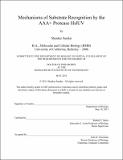Mechanisms of substrate recognition by the AAA+ protease HslUV
Author(s)
Sundar, Shankar
DownloadFull printable version (8.049Mb)
Alternative title
Understanding substrate recognition by the Ecoli protease HslUV
Other Contributors
Massachusetts Institute of Technology. Dept. of Biology.
Advisor
Robert T. Sauer.
Terms of use
Metadata
Show full item recordAbstract
Protein degradation is a central component of all biological processes. The proteome must constantly change in response to environmental stimuli. As a result, protein synthesis and regulated proteolysis are vital to cell survival. In Escherichia coli, the protease HslUV is one of five ATP-dependent proteases that shoulder the major burden of intracellular protein degradation. Although ample data exist for describing the structural architecture of the HslUV protease, very little is known about its mechanisms of function. I took a two-pronged approach to understand the functional principles that govern this protease. My first goal was to understand the rules of substrate recognition. To do so, I performed a variety of experiments on two model proteins: Arc repressor and [chi]cIN repressor. I found that both substrates had common requirements for HslUV degradation, suggesting a conserved mode of recognition by this protease. Mutagenesis of either substrate terminus affected binding and degradation kinetics. While degron mutations generally affect only enzyme-substrate binding properties in other bacterial proteases, the changes described here often affected the maximal rate of HslUV degradation. Moreover, specific occlusion of either the N-terminus or C-terminus of these substrates resulted in a substantial defect in degradation. A synergistic inhibitory effect was observed for the simultaneous masking of both termini. These results suggested a mechanism of tethering prior to engagement for degradation of HslUV substrates. I then sought to define the regions of HslU that were important for recognition and found that two segments, the GYVG pore loop and the intermediate (I) domain, played crucial roles. Investigation of mutants altered at these sites supported a mechanism of tethering of the substrate C-terminus to the I domain and engagement of the substrate N-terminus in the pore. I showed that degradation of an Arc substrate proceeds processively from the N-terminus towards the Cterminus, lending further support to this idea. Interestingly, I also discovered that the I domain plays a very important role in ATP hydrolysis by HslU and coordinates substrate recognition and stimulation of ATP turnover. This trait appears to be unique for HslU and is not a property of the accessory domains of other AAA+ protein unfolding machines.
Description
Thesis (Ph. D.)--Massachusetts Institute of Technology, Dept. of Biology, 2011. This electronic version was submitted by the student author. The certified thesis is available in the Institute Archives and Special Collections. Cataloged from student submitted PDF version of thesis. Includes bibliographical references (p. 104-119).
Date issued
2011Department
Massachusetts Institute of Technology. Department of BiologyPublisher
Massachusetts Institute of Technology
Keywords
Biology.